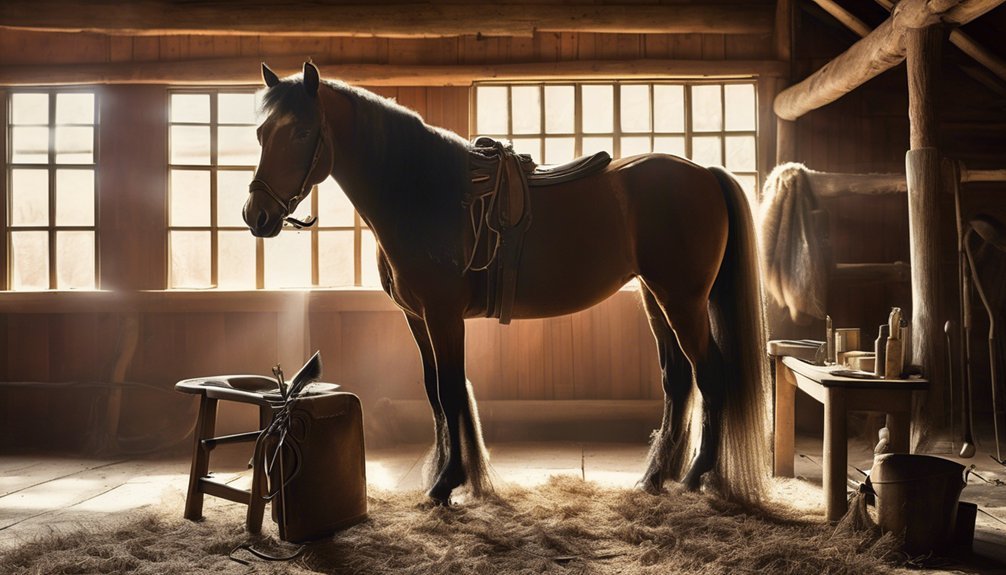
Grooming horses with curly coats can be a rewarding yet challenging task. These unique coats require specific techniques to keep them healthy and free from matting. Understanding their characteristics and the right grooming tools is essential for effective care. As you embark on this journey, you'll discover how proper grooming not only enhances your horse's coat but also strengthens your bond. Let's explore the best practices to ensure your curly-coated companion looks and feels their best.
Key Takeaways
- Regular brushing is essential to prevent matting and skin irritation in curly coats, ensuring overall health and comfort.
- Use specialized curly coat brushes and rubber curry combs to effectively remove dirt and debris without damaging the curls.
- Bathe with lukewarm water and sulfate-free shampoo, gently working through curls to maintain their unique texture.
- Apply a quality detangling spray before grooming to loosen knots, and use wide-toothed combs for gentle detangling.
- Transform grooming time into a bonding ritual by being patient and gentle, making the experience enjoyable for both you and your horse.
Understanding Curly Coats: Unique Characteristics
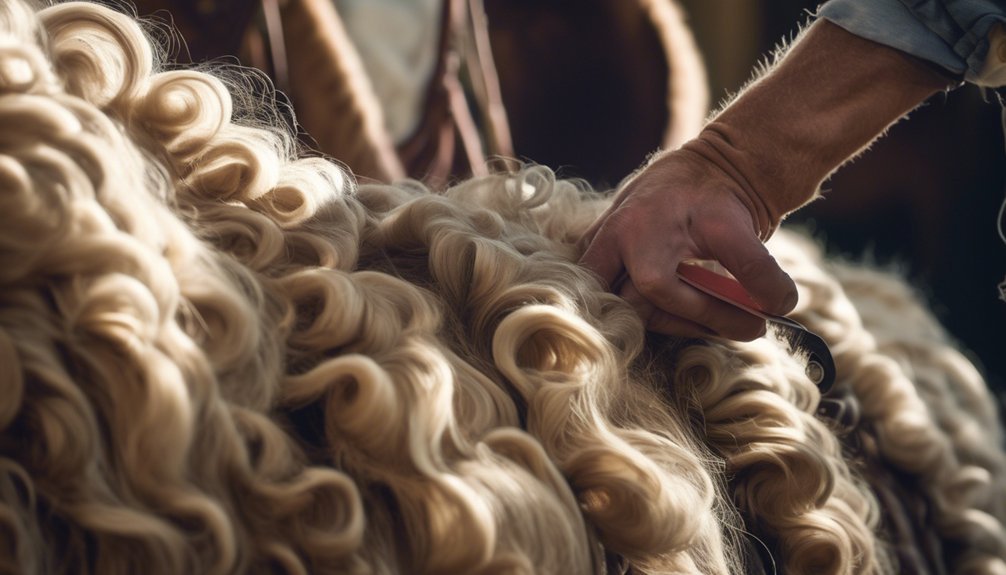
When you encounter a horse with a curly coat, you might be surprised by its distinctive appearance and unique texture, but understanding these characteristics can deepen your appreciation for these remarkable animals.
Curly coat genetics cause the hair to form tight curls, which not only sets them apart visually but also impacts their grooming needs. You may face specific grooming challenges, as the dense curls can trap dirt and debris more easily.
Regular brushing is essential, but you'll want to be gentle to avoid irritating their skin. Remember, these horses thrive in different climates, and maintaining their coat can be a rewarding experience.
Importance of Regular Grooming
Grooming isn't just about keeping your horse looking great; it plays a vital role in their overall health and well-being. Regular grooming provides numerous grooming benefits, helping to remove dirt, debris, and loose hair while stimulating blood circulation. This not only promotes a healthy coat but also strengthens your bond with your horse.
For those with curly coats, consistent coat maintenance is essential, as it prevents matting and tangles that can lead to skin irritations. Additionally, grooming gives you a chance to check for injuries or abnormalities, ensuring your horse remains in peak condition.
Choosing the Right Tools for Curly Coats
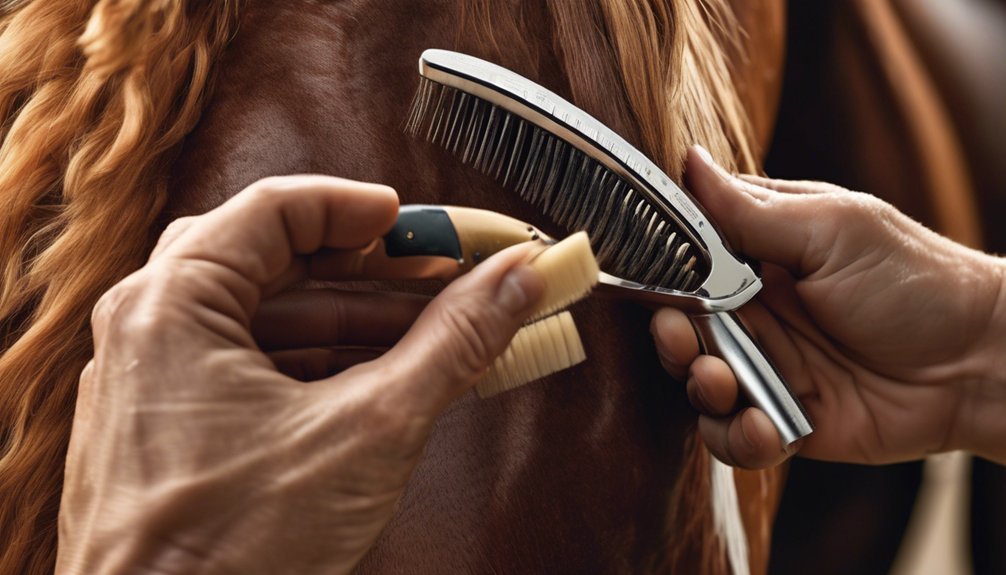
What tools should you consider for managing a curly coat? Selecting the right grooming tools is essential to keep your horse's coat healthy and shiny. Curly coat brushes, designed specifically for textured hair, can help detangle without causing discomfort. Opt for tools made from natural materials like wood or rubber, which provide a gentle yet effective grooming experience.
| Tool Type | Description | Recommended Material |
|---|---|---|
| Curly Coat Brush | Detangles and smooths | Natural bristles |
| Rubber Curry Comb | Removes dirt and debris | Rubber |
| Hoof Pick | Cleans hooves | Stainless steel |
| Mane Comb | Untangles mane | Plastic |
| Soft Grooming Mitt | Stimulates skin | Soft fabric |
Using the right tools not only enhances your bond but also promotes your horse's well-being.
Bathing Techniques for Curly Horses
How can you ensure your curly horse enjoys bath time while keeping its coat healthy? Start with the right bathtub temperature; lukewarm water keeps your horse comfortable and relaxed.
Choose a gentle, sulfate-free shampoo specifically designed for curly coats to maintain moisture and avoid stripping natural oils. As you lather, use your fingers to gently work through the curls, being mindful of sensitive areas.
Rinse thoroughly, ensuring no shampoo residue remains, as this can irritate the skin. After bathing, consider a light conditioner to enhance softness and manageability.
Remember to reward your horse with a treat afterward, reinforcing that bath time can be a pleasant experience. Your bond will deepen as you care for their unique coat together.
Effective Detangling Methods
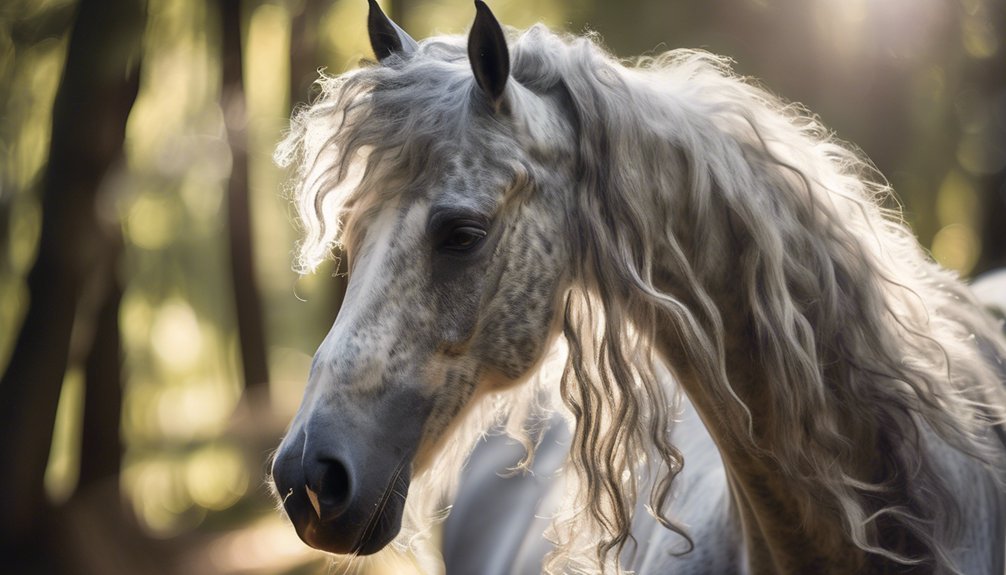
While dealing with tangles in your curly horse's mane or tail can be frustrating, employing effective detangling methods can transform the experience into a positive one for both you and your horse.
Here are four essential steps to follow:
- Use a Quality Detangling Spray: Apply a generous amount to loosen knots and make brushing easier.
- Choose the Right Grooming Brushes: Opt for wide-toothed combs and soft-bristle brushes that won't pull or damage the hair.
- Work from the Bottom Up: Start detangling at the ends, gradually working your way to the roots to minimize breakage.
- Be Gentle and Patient: Take your time; your horse will appreciate your tender touch and care.
With these techniques, grooming becomes a bonding ritual rather than a chore.
Maintaining Skin Health
As you focus on maintaining your horse's skin health, it's essential to recognize that a well-groomed coat is more than just a visual asset; it reflects overall well-being.
Regular skin moisturization is crucial, especially for curly coats that tend to trap moisture and dirt. Use a high-quality equine moisturizer to keep the skin supple and hydrated, preventing dryness and irritation.
Additionally, consider your horse's environment to promote allergy prevention. Regularly check for allergens like pollen or dust, and maintain a clean living space.
Bathing your horse with gentle, hypoallergenic shampoos can help reduce irritants.
Managing Shedding Seasons
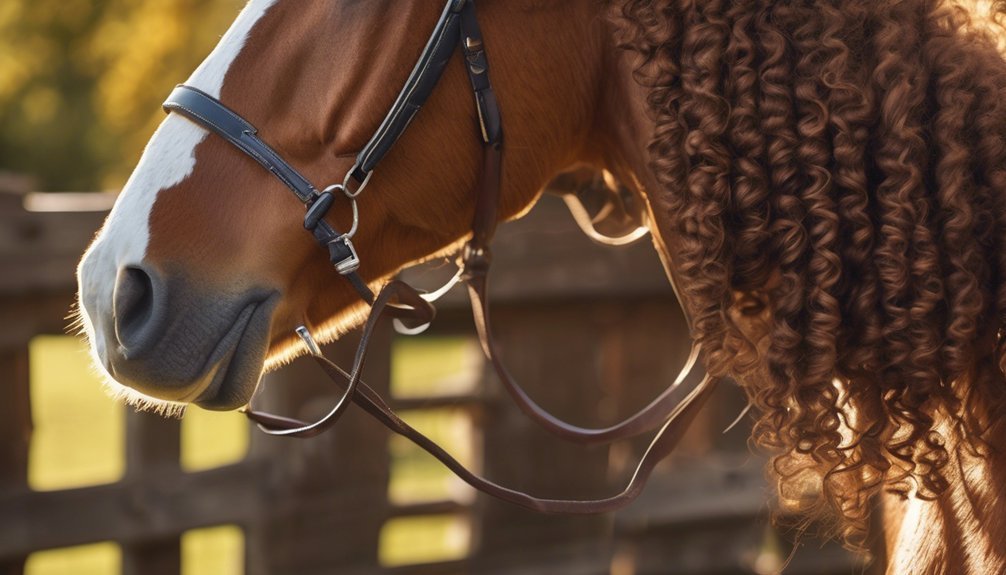
Managing shedding seasons can feel overwhelming, but with the right approach, you can make the process smoother for both you and your horse.
Effective shedding management requires attention and care, especially during seasonal changes. Here are four essential tips to simplify the process:
- Regular Grooming: Brush your horse daily to remove loose hair and debris.
- Use the Right Tools: Invest in a quality shedding blade or rubber curry comb to tackle tough patches.
- Monitor Environment: Keep your horse's living space clean to minimize allergens and irritants.
- Hydration: Ensure your horse has access to fresh water to support skin health during shedding.
Dietary Considerations for Healthy Coats
To maintain a healthy coat, it's crucial to focus on your horse's diet, since nutrition directly impacts their skin and fur quality.
Start by ensuring they receive a balanced diet rich in essential fatty acids, vitamins, and minerals. Omega-3 and Omega-6 fatty acids, found in flaxseed or fish oil, work wonders for coat nutrition, giving your horse that desirable shine.
Incorporating dietary supplements can also enhance their overall health; look for those specifically designed to improve coat quality. Biotin, zinc, and amino acids are essential for strong hair growth and skin vitality.
Grooming Routine: Establishing a Schedule
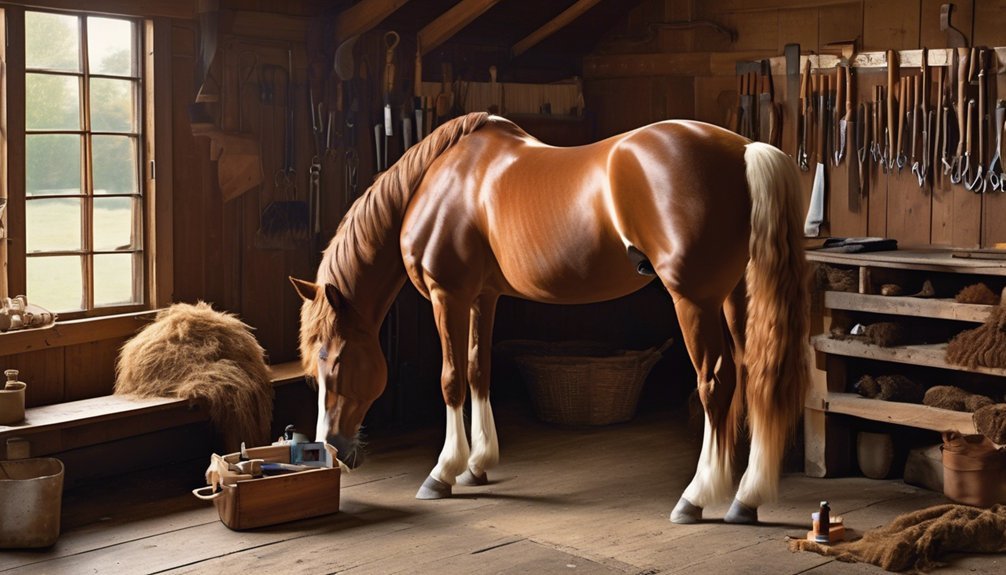
A well-nourished horse deserves a grooming routine that matches its dietary care.
Establishing a consistent schedule not only enhances your bond but also promotes overall health.
Here's how to create an effective grooming routine:
- Daily Grooming: Brush your horse each day to remove dirt and debris.
- Weekly Deep Cleansing: Set aside time weekly for a thorough wash and inspection.
- Regular Hoof Care: Incorporate hoof checks and cleaning every other day to prevent issues.
- Seasonal Adjustments: Adapt your grooming frequency based on changing weather and coat condition.
Tips for Keeping Your Horse Calm During Grooming
While grooming can be a relaxing experience for both you and your horse, it's essential to create a calm environment that eases any anxiety your horse might feel. To help you achieve this, consider these calming techniques:
| Technique | Description |
|---|---|
| Soft Music | Play gentle tunes to soothe your horse. |
| Consistent Voice | Use a soft, reassuring tone while speaking. |
| Slow Movements | Groom with deliberate, gentle motions. |
| Treat Rewards | Offer treats to create a positive association. |
Frequently Asked Questions
Can Curly Coat Horses Be Clipped or Shaved?
Yes, you can clip or shave curly coat horses, but be cautious. Using proper clipping techniques is vital for coat maintenance. Always consider your horse's comfort and skin sensitivity during the process to ensure a positive experience.
Are There Specific Breeds Known for Curly Coats?
Curly coats symbolize uniqueness and resilience. Breeds like the American Bashkir Curly and the Barb highlight this beauty. Understanding grooming techniques for these curly coat breeds deepens your connection, enhancing your bond with such remarkable horses.
How Does Humidity Affect Curly Coats?
Humidity affects curly coats significantly; it can lead to frizz and difficulty in coat maintenance. You'll notice how moisture can enhance their texture, making it vital to adjust your grooming routine accordingly for optimal results.
Can I Use Regular Grooming Products on Curly Coats?
You can use regular grooming products, but consider their suitability for curly coats. Choose gentle formulas and tailored grooming techniques to maintain moisture and avoid damage. Your horse deserves the best care for its unique coat!
What Are Common Skin Issues in Curly-Coated Horses?
Curly-coated horses often face skin sensitivity, flaky patches, and irritation. You'll find that regular coat maintenance, including moisturizing and gentle cleansing, helps keep their skin healthy, vibrant, and comfortable. Treat them with care and love!
Conclusion
By embracing these grooming tips, you're not just caring for your horse's curly coat; you're nurturing a bond that feels as strong as the mightiest oak. Regular grooming transforms a simple task into a cherished ritual, fostering trust and comfort between you and your horse. Remember, a well-groomed curly coat isn't just beautiful; it's a reflection of your dedication and love. So, grab those brushes, and turn grooming into a delightful experience for both of you!





